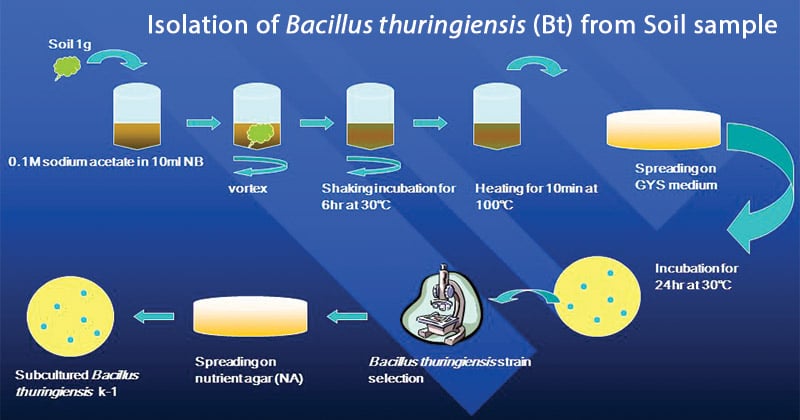- Bacillus thuringiensis (Bt) is an ubiquitous, Gram-positive and sporulating bacterium that synthesizes insecticidal proteins with specificity against a wide range of insects during sporulation (Cry and Cyt) and vegetative growth (Vip and Sip).
- These proteins have portrayed Bt as an environment-friendly alternative to chemical insecticides.

Interesting Science Videos
Principle of Isolation of Bacillus thuringiensis
Widely used methodologies to isolate Bt from soil consist of a thermal shock treatment followed by selective germination of spores. Thermal shock is employed to eliminate all bacteria incapable of producing endospores from the sample soil. The samples are then diluted many folds to eliminate the amount of humic material within the soil and to reduce the overall colony forming units within the sample. The diluted samples are then cultured on nutrient agar in order to give the spores chance to germinate on media with adequate nutrients and at optimal temperature. The media offers favourable growth conditions for a wide range of bacteria including Bacillus thuringiensis. A series of selection tests are thus further employed to identify Bacillus thuringiensis alone from the range of bacteria present in the crude soil sample population. Common important tests include Sodium acetate selection test, Gram’s staining, Amino black and Ziehl’s carbol fuchsin staining, Endospore staining, Catalase test, checking for growth above 45oC and looking for presence of parasporal bodies among others.
Procedure of Isolation of Bacillus thuringiensis
- Obtain about 20 g of cultivated or non-cultivated soil sample with a tubular soil sampler after removing the 2-3 cm of the top layer.
- Place samples at 4 ºC in 50 ml (sterile) centrifuge tubes or zip-lock bags until isolation.
- Suspend the soil samples of 1 g in 10ml 0.85% NaCl.
- Heat with shaking at 70°C for 10 min.
- Plate aliquots of 100μl of suspension onto nutrient agar (0.5% Peptone, 0.3% beef extract, 0.5% NaCl and 1.5% agar).
- Incubate plates at 30±2°C for 48h.
- Sub-culture bacterial colonies exhibiting Bt-like phenotype for single-colony isolation again on fresh plates and incubate.
- Stain the culture with amino black and Ziehl’s carbol fuchsin and examine under a standard light microscope for preliminary identification.
Expected Results of Isolation of Bacillus thuringiensis
- Colonies mostly appear matte white colour, flat, dry and with uneven borders.
- Cultures that show parasporal crystals dyed black on microscopic observation may be of importance and require storing.
Reference
- (PDF) Isolation and Characterization of Bacillus thuringiensis Isolated from Soil and their Possible Impact on Culex pipiens Larvae. Available from: https://www.researchgate.net/publication/299845038_Isolation_and_Characterization_of_Bacillus_thuringiensis_Isolated_from_Soil_and_their_Possible_Impact_on_Culex_pipiens_Larvae [accessed Nov 04 2018].
- Travers, R.S., Martin, P.A. and Reicheferfer, C.F. 1987. Selective process for efficient isolation of soil Bacillus spp. Applied and Environmental Microbiology. 53, 1263-1266.
- http://biopublisher.ca/index.php/bt/article/html/2019/
- https://www.sciencedirect.com/science/article/pii/S0167701208002352
- https://aem.asm.org/content/aem/53/6/1263.full.pdf
- https://core.ac.uk/download/pdf/39664802.pdf
